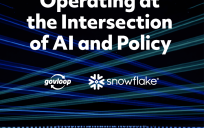In a world increasingly influenced by Artificial Intelligence (AI), the quest for genuine authorship has never been more crucial. If you’re going to build trust within your agency, teams, social media presence, and customer/client base, you need to exude authenticity. With the rapid evolution of AI technology, writers face new challenges in maintaining authenticity and trust while leveraging these digital tools. Government employees, agency leaders, and young professionals can uphold their unique voices amidst the AI revolution.

Understanding Artificial Intelligence
Before we begin exploring the intersection of AI and authorship, let’s define what Artificial Intelligence (AI) actually is. AI refers to the simulation of human intelligence processes by machines, particularly computer systems. These processes include learning, reasoning, and self-correction. AI can be used to perform various tasks, from automating simple calculations to generating creative content. AI results depend on the sources from which they draw their intelligence.
AI in Writing
AI has made significant strides in writing content. For example, tools like Jasper.ai and GPT-3 can generate entire articles based on a prompt. A professional might input a topic, and the AI will churn out a coherent piece of writing, complete with a structure and persuasive arguments. While this can be a time-saver, it raises legitimate concerns about authenticity and originality.
The Risks of Using AI-Generated Content
Complete reliance on AI-generated content with direct copy-paste behavior undermines authenticity. Think about this example: An artist shares his/her original works on-line. An AI user enters that artist’s name in their prompt to emulate their style when creating an image or a piece of writing. Now there’s an ownership and plagiarism risk. Here are some general risks that can be associated with disingenuous content:
- Distrust of the Author: Readers may question the credibility of content if they suspect it was generated by AI. Trust is a vital component of any author’s relationship with their audience.
- Bias in AI Content: AI operates based on the data it has been trained on, which may contain biases. If an AI tool draws from biased sources, the final content could unintentionally perpetuate those biases.
- Laziness and Skill Development: Over-reliance on AI can lead to complacency, stunting the development of personal writing skills and critical thinking.
Maintaining Your Unique Voice
An author’s voice is akin to a personal brand. It reflects individuality and perspective. Similarly, a company’s or agency’s voice is integral to its brand identity and purpose. Here’s how to maintain proper voice while using AI:
- Use AI for Assistance, Not Composition: Employ AI tools to help with outlining and research, but compose the content yourself. This ensures your unique style and insights shine through.
- Integrate Your Personal Touch: Even when using AI to draft, infuse your personality into the final product. Adjust tone, language, and examples to align with your brand.
- Be Transparent with Disclaimers: Consider adding a disclaimer statement at the end of public posts, such as, “This content was not generated by AI. The voice and composition are my own.” Or “This content was brainstormed using AI, but the voice and composition belong entirely to the author.” This reinforces the authenticity of your work.
Ethical Considerations in AI Authorship
Ethics play a significant role in the responsible use of AI in writing. To ensure integrity, consider the following:
- Avoiding Plagiarism: Always verify the originality of your work. Use plagiarism checkers to ensure the content isn’t lifted from existing sources. Some solid plagiarism checkers are JustDone.ai – PlagScan – Copyleaks.
- Source Verification: Ensure the AI tool references appropriate and credible material. Cross-check AI-generated information with trusted sources. “Fact Check” has become a popular term that many out there will use to build trust. For a great resource that covers how to verify your sources, consult AllAboutAI.
Building Trust through Genuine Authorship
AI is incredibly pervasive now. Building and maintaining trust has never been more important and more elusive. Here are some ways to foster genuine authorship:
- Engage with Your Audience: Regularly interact with your readers to understand their needs and to see/hear what they’re saying. This engagement fosters a community based on trust and shared values.
- Continual Learning: Keep refining your skills. Attend workshops, take courses, and seek feedback to grow as a writer. Share your educational and training achievements publicly to demonstrate the value you place on authenticity.
- Transparent Communication: Clearly communicate the role AI plays in your writing process. This transparency helps manage reader expectations and reinforces the authenticity of your content. There’s that idea about a disclaimer statement again!
Conclusion
We have every right to leverage technology to drive productivity, but we must exercise extreme caution when navigating the landscape of AI. Genuine authorship requires diligence and transparency in how we use AI for building our content. By understanding the potential risks, maintaining a unique voice, and adhering to ethical guidelines, writers can harness AI as a tool for creativity without compromising their personal or company brand.
For those looking to integrate AI responsibly, start by focusing on AI-assisted research and outlining; not composition. This approach allows you to maintain control over your voice while benefiting from the efficiencies AI offers. In doing so, you’ll not only enhance your writing but also build trust and authenticity in your authorship. If you want to see how all of this plays out, check out Artform Agency. This organization is laser-focused on how and when to use AI effectively. They have their collective fingers on the pulse of making the best use of the AI world. Check out their extensive YouTube channel.
DISCLAIMER: AI was used to generate the outline for this blog post, but the composition and suggested resources are entirely from the author.
The multi-faceted nature of Susan Powell’s professional background paints the picture of a lifetime learner who has always taken full control of her career path and decisions to apply her learning experiences in the most productive ways possible. Susan has brought her passion for writing and communications to every career upgrade and role, which helped her to secure the Marketing Director position for a cybersecurity company that she holds today. Fueled by her continued enthusiasm for earning applicable certifications, she continues to develop her marketing prowess and channel partner marketing skills. This former elementary teacher-turned-marketer is still a happy work-in-progress.





Leave a Reply
You must be logged in to post a comment.